Poultry Processing Plant MBR
Dynatec Systems’ installed a HiBrid™ UF for MBR service at a poultry processing plant that processes 800,000 gallons per day. The Membrane Bioreactor (MBR) operates at high flux which means less membrane surface area is required and ultimately saving capital cost. Dynatec Systems has installed over 600 membrane systems providing wastewater solutions since 1979. The HiBrid™ MBR UF combines sound engineering and effective process design with state-of-the-art materials of construction.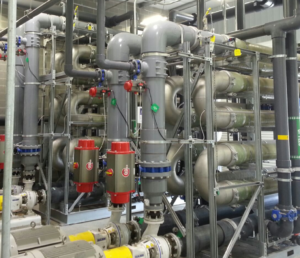
Outsource your wastewater service! Dynatec will design-build-own-operate-maintain (DBOOM) your wastewater treatment plant allowing you to concentrate on your core business.
The industrial MBR is the ideal bioreactor configuration for treatment of organic or inorganic contaminants present in industrial wastewaters. MBR’s operate at a higher efficiency while achieving consistent design performance objectives. This makes MBR a more cost effective method of industrial wastewater treatment when performance and tank requirements are considered.
Industrial Membrane Bioreactors Benefits:
- Higher flux
- Lower costs
- Better membranes
- Improved permeate quality
- Less operator attention and maintenance
Industrial Membrane Bioreactor (MBR) Applications
Dynatec’s industrial MBR is the ideal biological system for industrial wastewater treatment. It is designed to handle high strength wastewater containing high concentrations of:
- Biochemical Oxygen Demand (BOD)
- Chemical Oxygen Demand (COD)
- Oil & Grease (FOG)
- Volatiles
- Metals
- Ammonia
- Nitrate
- Inorganic
The performance is not affected by changes in sludge settleability like the conventional systems, making it the wise choice for industrial wastewater treatment systems that have difficult-to-treat waste streams. Dynatec’s MBRs can effectively handle industrial wastewater streams that would otherwise be toxic or inhibitory to other biological treatment systems.
Backed by decades of experience with MBRs, Dynatec has developed many unique process solutions necessary for industrial wastewater treatment applications such as:
- Landfill leachate
- Hazardous landfill leachate with metals removal
- Automotive manufacturing wastewater
- Food manufacturing wastewater
- Titanium processing wastewater
Contact Dynatec Systems today to discuss your wastewater solutions.
https://www.dynatecsystems.com/industries/food-and-beverage/poultry-processing-wastewater-treatment/
Wastewater Reuse – Phosphate Mine
Mining operations can produce a large amount of wastewater in the form of spent liquor that requires treatment. The wastewater stream has a high concentration of contaminants that need to be separated from the water before it can be discharged or reused. Dynatec has provided a system to a phosphate mining operation that treats five million gallons of wastewater per day. The customer was motivated to put a treatment/reuse system to separate a portion of the compounds in the wastewater for reuse. Also, the desired water quality for discharge met requirements for reuse of several water users in the plant.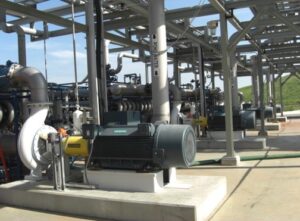
Dynatec was asked to conduct a pilot to study the feasibility of using membrane technology to purify the wastewater so that it could be reused in mining operations at the site. After several months of piloting, Dynatec was commissioned to supply five ultrafiltration skids, each capable of producing one million gallons per day of permeate. The ultrafilters were a part of the reuse system that also includes nanofiltration and reverse osmosis to produce water and product for reuse.
Due to the highly saturated wastewater stream, the pH of the wastewater was maintained at 1.8 s.u. to keep specific contaminants from precipitating in the membrane systems. The ultrafilters have successfully operated at this pH for over 10 years and their life span has not been negatively impacted by the nature of the wastewater.
The high strength spent liquor is processed through a series of membranes from UF to NF to RO. The customer has found reuse applications for reject and permeate from the membrane systems. The final system has alleviated concerns of future environmental infractions and has saved the customer money.
Contact Dynatec Systems to discuss your wastewater solution.
https://www.dynatecsystems.com/technologies/recovery-and-reuse/
Ultrafiltration Membrane System
Automotive connectors manufacturer of quick connectors for transfer of engine oil cooling fluids was in need of a wastewater treatment system to address oil and grease and heavy metal contaminants in their discharge. Based on understanding of the waste stream and ability to provide a cost effective solution, Dynatec was selected to provide a system that would produce effluent that reliably met the sewer discharge requirements. By using a combination of free oil separation and an ultrafiltration membrane system, in addition to removing all of the suspended solids, the Dynatec supplied system consistently provides effluent meeting discharge requirements.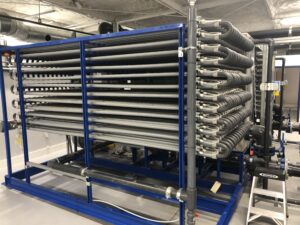
Automotive Connectors Manufacturer Contaminants removed:
- Biochemical oxygen demand (BOD)
- Oil/grease
- Suspended solids
- Chemical oxygen demand (COD)
- Zinc
- Chrome
Dynatec Systems industry-leading tubular ultrafiltration (UF) system is used to treat a broad range of industrial wastewater by separating insoluble components from waste streams. As a cost effective and simple solution for separating insoluble components and colloidal contaminants from a waste stream, wastewater UF offers significant advantages over conventional separation. It is a useful process that does not require chemicals or much space to separate insoluble contaminants.
UF is a pressure-driven process that removes the following from wastewater and other solutions:
- Emulsified oils
- Metal hydroxides
- Colloids
- Emulsions
- Dispersed material
- Suspended solids
- Other large molecular-weight materials
Ultrafiltration systems are also capable of concentrating:
- Bacteria
- Some proteins
- Some dyes
- Colloidal or emulsified components
Ultrafiltration systems excels at the clarification of solutions containing:
- Suspended solids
- Bacteria
- High concentrations of macromolecules including:
- Oil and water
- Fruit juice
- Milk
- Whey
- Electro-coat paints
- Pharmaceuticals
- Poly-vinyl alcohol and indigo
- Potable water
- Tertiary wastewater
Ultrafiltration offers the following advantages over conventional separation:
- No chemical required
- Very little labor required
- Simple mechanical process
- Less sludge
- Ability to concentrate the retentate for beneficial use
- Less space required
- Overall lower operating costs
Tubular Configuration:
- Higher permeate rate
- Lower rates of fouling
- Higher concentration of retentate
- Easier to clean
- Longer membrane life
- Low operating cost
For more information on wastewater treatment systems to address oil and grease and heavy metal contaminants, please contact us today.
Automotive Parts Manufacturer
An automotive parts manufacturer was in need of a system to process oily waste water. An ultrafiltration (UF) system was selected based upon its ability to consistently meet the discharge requirements without chemicals and limited operator involvement. This ultrafiltration (UF) system removes oil and reduces zinc in compliance with discharge requirements.
Ultrafiltration excels at the clarification of solutions containing suspended solids, bacteria, and high concentrations of macromolecules, including oil this making this an excellent solution to this problem.
Automotive Parts Manufacturer Contaminants Removed
- Biochemical Oxygen Demand (BOD)
- Oil and Grease (O&G)
- Suspended solids
- Zinc
- Lead
Dynatec Systems industry-leading tubular ultrafiltration (UF) system is used to treat a broad range of industrial wastewater by separating insoluble components from waste streams. As a cost effective and simple solution for separating insoluble components and colloidal contaminants from a waste stream, wastewater UF offers significant advantages over conventional separation. It is a useful process that does not require chemicals or much space to separate insoluble contaminants.
UF is a pressure-driven process that removes the following from wastewater and other solutions:
- Emulsified oils
- Metal hydroxides
- Colloids
- Emulsions
- Dispersed material
- Suspended solids
- Other large molecular-weight materials
Ultrafiltration systems are also capable of concentrating:
- Bacteria
- Some proteins
- Some dyes
- Colloidal or emulsified components
Ultrafiltration systems excels at the clarification of solutions containing:
- Suspended solids
- Bacteria
- High concentrations of macromolecules including:
- Oil and water
- Fruit juice
- Milk
- Whey
- Electro-coat paints
- Pharmaceuticals
- Poly-vinyl alcohol and indigo
- Potable water
- Tertiary wastewater
Ultrafiltration offers the following advantages over conventional separation:
- No chemical required
- Very little labor required
- Simple mechanical process
- Less sludge
- Ability to concentrate the retentate for beneficial use
- Less space required
- Overall lower operating costs
Tubular Configuration:
- Higher permeate rate
- Lower rates of fouling
- Higher concentration of retentate
- Easier to clean
- Longer membrane life
- Low operating cost
For more information on ultrafiltration for the removal of oils and grease, please contact us today.
https://www.dynatecsystems.com/technologies/membrane-technologies/ultrafiltration-systems/
Landfill Leachate treatment system
Landfill leachate treatment system for a hazardous waste landfill incorporates heavy metals pretreatment followed by a tubular MBR system.
The MBR reduces:
- ammonia
- phenol
- Polychlorinated Biphenyl (PCB)
- chemical oxygen demand (COD)
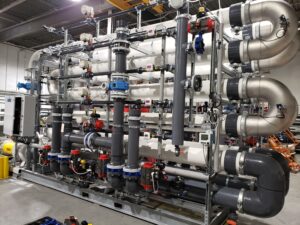
- volatiles and semi-volatiles
- and other contaminants adequately for discharge
The system reduces PFAS 30-60% and carbon is utilized to reduce PFAS to low ppt concentrations.
Landfill leachate treatment systems with Membrane Bioreactors (MBR)s have developed many unique process improvements for industrial wastewater applications. Dynatec successfully uses Ultrafiltration (UF), MBR and Reverse Osmosis (RO) for landfill leachate applications.
Landfill leachate treatment system requirements
Treatment can vary, depending on the discharge requirements, and the contaminants present
Landfill leachate is characterized by:
- High Total Dissolved Solids (TDS)
- Heavy metals
- High BOD
- Color
- High COD
- High ammonia
Landfill leachate treatment systems options
The MBR option: an aerated biological mixed liquor process operating at very high solids concentrations.
The advantages are:
- Long sludge age produces a well acclimated biomass. High concentration (typically 12,000 to 20,000 mg/l) provides very high rates of reaction
- Excellent nitrification and de-nitrification
- Smaller footprint then conventional aerated systems
- High-quality effluent as a result of using membranes for final clarification
- Lower sludge production than conventional systems
Typical MBR results in landfills:
| Parameter | BOD | COD | TSS | Ammonia |
|---|---|---|---|---|
| Influent | 500 | 4000 | 150 | 1000 |
| Effluent | <5 | 800 | <5 | <1 |
| % Removal | >99% | 80% | >96% | >99% |
The system produces bio-sludge, which can either be dewatered for disposal, or disposed of as a liquid sludge.
Alternative landfill leachate treatment options:
- Chemical precipitation of metals before MBR treatment
- RO after MBR treatment removes organic and inorganic contaminants, and color
- UF followed by RO
The two effluent streams from a RO system are:
- Permeate
- Concentrate (or reject)
This can be re-injected into the landfill. Its long-term effects on leachate concentrations should be considered.
Conclusion
The MBR process provides the highest possible levels of organic removal with essentially zero suspended solids in the effluent. This is the ideal feed system for RO treatment.
RO permeate can be used for other non-potable purposes:
- Irrigation
- Truck washing
- Dust control
Dynatec membrane treatment systems have successfully provided outstanding performance in many landfill leachate applications. Considerations for this technology include:
- Membrane treatment offers reliable, consistent landfill leachate
- Systems are highly cost effective, and require low levels of operator interface
- The best membrane system configuration for each application should be individually evaluated
- Membrane treatment is broadly applied in the US and abroad
Contact Dynatec Systems today to discuss your landfill leachate treatment solution.
https://www.dynatecsystems.com/industries/landfill-leachate-treatment/
Upgrades using existing assets
Upgrades using existing assets
When discharge regulations tighten, the need for water reuse grows, or wastewater volumes increase, existing Sequencing Batch Reactor (SBR) systems often become inadequate. In order to provide a solution with low capital cost in part by reusing existing assets, existing SBR plants can be converted to Membrane Bioreactors (MBR). This can usually be done by adding an out-of-basin tubular ultrafilter (UF) to the process. Using a Dynatec out-of-basin UF as part of an SBR to MBR conversion is the most cost-effective and easy to implement way to:
- Improve biological system performance
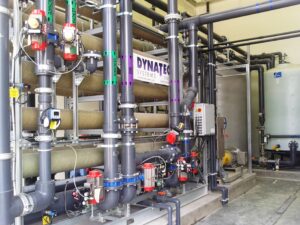
- Expand capacity
- Handle increase in strength of waste
- Mitigate upsets
- Reduce operator time
- Achieve consistent performance
Dynatec has used existing assets from SBR systems to convert to an MBR at many site including at landfills, food and beverage plants, chemical manufacturing, and automotive manufacturing facilities.
The industrial MBR is the ideal bioreactor configuration for treatment of organic or inorganic contaminants present in industrial wastewaters. MBR’s operate at a higher efficiency while achieving consistent design performance objectives. This makes MBR a more cost effective method of industrial wastewater treatment when performance and tank requirements are considered.
Industrial Membrane Bioreactors Benefits:
- Higher flux
- Lower costs
- Better membranes
- Improved permeate quality
- Less operator attention and maintenance
Applications
Dynatec’s industrial MBR is the ideal biological system for industrial wastewater treatment. It is designed to handle high strength wastewater containing high concentrations of:
- Biochemical Oxygen Demand (BOD)
- Chemical Oxygen Demand (COD)
- Oil & Grease (FOG)
- Volatiles
- Metals
- Ammonia
- Nitrate
- Inorganic
The performance is not affected by changes in sludge settleability like the conventional systems, making it the wise choice for industrial wastewater treatment systems that have difficult-to-treat waste streams. Dynatec’s MBRs can effectively handle industrial wastewater streams that would otherwise be toxic or inhibitory to other biological treatment systems.
Backed by decades of experience with MBRs, Dynatec has developed many unique process solutions necessary for industrial wastewater treatment applications such as:
- Landfill leachate
- Hazardous landfill leachate with metals removal
- Automotive manufacturing wastewater
- Food manufacturing wastewater
- Titanium processing wastewater
Contact Dynatec Systems today to discuss your wastewater solution.
Paint Manufacturer Reuses Latex
A paint manufacturer engaged Dynatec to provide a system to separate latex from wastewater and reuse it in the production of paint
The Problem
The company was using a chemically assisted, rotary drum vacuum pre-coat filter that was expensive to operate and created a lot of sludge which was expensive to dispose.
The Solution
The white paint wastewater was segregated from the colors, and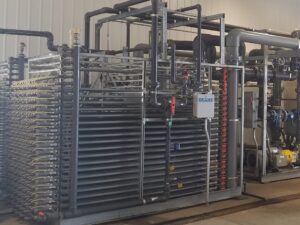 processed separately. The concentrate of white latex solids were used in the manufacture of new white paint.
processed separately. The concentrate of white latex solids were used in the manufacture of new white paint.
The paint solids from the colored paints can be concentrated to as high as 20% (typical paint contains between 45% and 55% solids) using wide channel ultrafiltration. The paint solids are concentrated and reused to make a grey paint. The water can be discharged to sewer, since it contains no solids, or it can be reused as wash water.
Special circulation pumps are also used to handle the high solids loadings.
Return on investment
The return on investment was high. The latex from the white paint wastewater is reused in the production process for manufacture of new paint. The paint solids from the colored paint wastewater is recovered as a saleable low quality paint product. The cost for disposal of the solids removed by the old chemical treatment system has been reduced by 90%. The wastewater from both processes is discharged to sewer.
Significant Savings:
No sludge
Beneficial use for latex
Water quality for discharge is better
Much less operator time
No chemicals
Ultrafiltration excels at the clarification of solutions containing:
Suspended solids
Bacteria
High concentrations of macromolecules including:
Oil and water
Fruit juice
Milk
Latex
Whey
Electro-coat paints
Pharmaceuticals
Poly-vinyl alcohol
Potable water
Tertiary wastewater
Some proteins
Some dyes
Oils
Colloidal or emulsified components
Contact Dynatec Systems today to discuss your wastewater solution!
https://www.dynatecsystems.com/technologies/membrane-technologies/ultrafiltration-systems/
Reuse Water in Juice Plant
Reuse water ability in a new treatment system was needed in a juice processing company for other plant processes. The high strength wastewater, with a COD of 16,000mg/L, needed to meet stringent effluent criteria to make this possible.
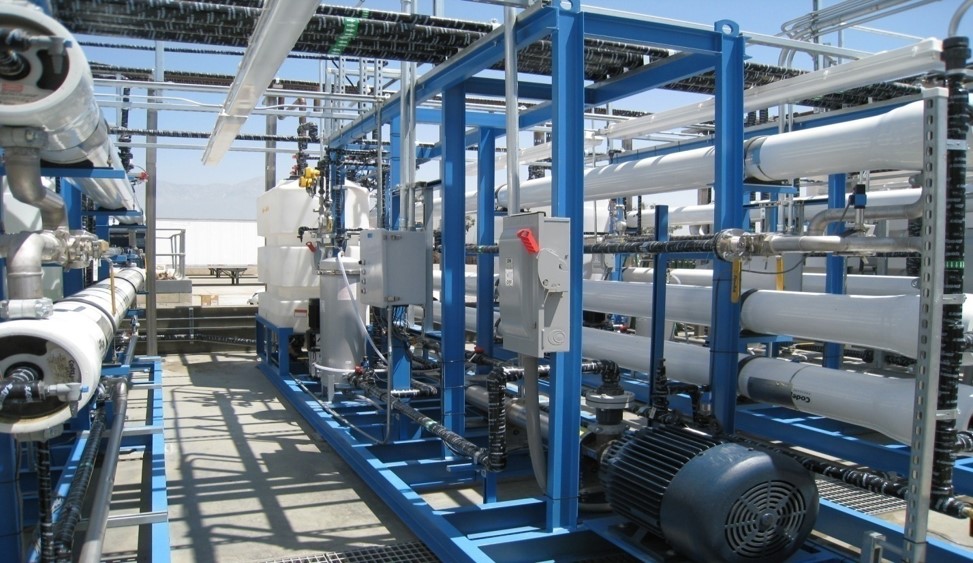
Reuse water in juice plant
The solution, provided by Dynatec, includes a membrane bioreactor (MBR) followed by a double pass reverse osmosis (RO) system. The permeate meets all limits for BOD, COD, metals, TSS, and TDS.
Reuse water systems have been provided by Dynatec Systems to many industries. The ability to recover and reuse water has many benefits.
- Saving on water costs
- Saving on wastewater disposal charges
- Decreased environmental impact
- Protection from regulatory changes
- Decrease dependence on water provider/source
- Ability to expand without affecting water demand
- Overcome water scarcity issues
- Consistently high-quality for water reuse
Ultrafiltration (UF), Membrane Bioreactor (MBR), Nanofiltration (NF) and Reverse Osmosis (RO) are employed by Dynatec for water reuse projects. Water recovery and water reuse has been successfully implemented with industrial and sanitary wastewater streams for:
- Cooling tower make up
- Boiler feed
- Irrigation
- Toilet flushing
- Direct potable reuse
- Cleaning/wash applications
- Rinse processes
- Painting processes
- Other plant processes
Reuse water systems provided by Dynatec Systems:
- Resorts, hotels, and retirement homes
- Golf courses
- Automotive companies
- Food and beverage companies
- Apartment buildings
- Landfills
- Mines
- Metal finishing plants
- Aerospace companies
For more information, please contact us today.
https://www.dynatecsystems.com/technologies/recovery-and-reuse/
Sanitary Wastewater Expansion
Sanitary wastewater expansion of a previously supplied MBR by Dynatec Systems for a mall was recently completed. The original system treated the sanitary wastewater generated at the mall and wastewater from several restaurants on the property. Recent changes at the mall, including the addition of residential units, resulted in greater wastewater volumes. The expansion was relatively fast and easy due to the modular nature of Dynatec’s UF skids. The permeate meets all requirements for direct discharge to the environment and the compact design fits the limited space available at the mall.
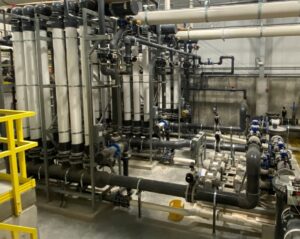
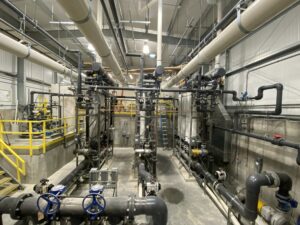
Sanitary wastewater from private communities, industrial and academic campuses, resorts, and various other facilities can be treated to meet discharge permit limits or to meet reuse standards. Dynatec provides systems that accomplish this in a small space and with low operating costs.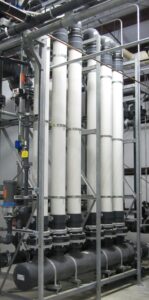
Membrane bioreactor (MBR) solutions provided
- Plant expansion
- Improved effluent quality
- Purification for direct discharge
- Existing plant upgrades
- Sequencing batch reactor (SBR) to MBR conversions
- Wastewater reuse for:
- Cooling tower
- Boiler
- Toilet flushing
- Irrigation applications
- Recovery and reuse of wastewater for:
- Apartment buildings
- Industrial campuses
- Academic campuses
- Hotels and resorts
- Golf courses
- Compact wastewater treatment systems
- Containerized/mobile sanitary treatment systems
- Water mining systems
Significant Benefits
- Lower energy cost allows operation in larger plants
- Robust tubular membranes reduce replacement cost
- High mixed liquor concentration reduces tankage required and higher treated water quality
- Small system footprint
- Easily expandable
- Safe automatic clean-in-place system protects operators
- Predictable, consistently high performance
- Remote monitoring – compatible with cell phone or iPad
Contaminants removed from sanitary wastewater
- Biochemical Oxygen Demand (BOD)
- Oils and Grease (O&G)
- Total Suspended Solids (TSS)
- Ammonia
- Total N
- Fecal Coliforms
Completely sealed within tough, protective vessels, the membranes never move
- Permanently sealed design
- Rigidly supported tubular membrane prevents breakage
- No odors or smells
- Automatic cleaning systems
- No exposure to waste or mixed liquor above tanks
When you need consistently high-quality effluent, consider Dynatec Systems’ MBR wastewater treatment systems. You can lower your capital and operating costs with a single, compact system requiring minimal operator attention.
For more information on sanitary wastewater expansion, please contact Dynatec to discuss.
https://www.dynatecsystems.com/industries/sanitary-wastewater/
Anaerobic digester and aerobic MBR followed by RO for whiskey manufacturer
Anaerobic digester and aerobic MBR followed by RO provided by Dynatec Systems. A whiskey manufacturer needed a wastewater treatment system to reduce very high organic content BOD and COD. As well as, solids content TSS of the wastewater stillage to achieve the demanding final treated water discharge standards. A membrane filter is used for pretreatment prior to the anaerobic system. The tubular membrane filter employed with the biological system is not dependent on the settling characteristics and produces very high-quality effluent.
The equipment was containerized to make the implementation as easy as possible.
Membrane bioreactors offer a unique and effective solution for the treatment and reuse of industrial wastewater in industries such as landfills, automotive, aerostructures, distilleries and dairies. Our industry-leading designs and innovation also deliver superior performance for sanitary wastewater and biological nutrient removal applications.
The MBR configuration has proven to be optimal for treatment of many industrial wastewaters when treatment efficiency is an important consideration.
The MBR is the ideal bioreactor configuration for treatment of organic or inorganic contaminants present in industrial wastewaters. MBRs operate at a higher efficiency while achieving consistent design performance objectives. This makes MBR a more cost effective method of treatment when performance and tank requirements are considered.
Bioreactor systems such as the conventional activated sludge system, sequencing batch reactor system and trickling filters are typically designed for operation at a lower volumetric removal rate, requiring larger tanks and more space. These conventional systems often experience upsets that inhibit settling and therefore require much more operator attention than a membrane bioreactor.
The MBR has proven to be optimal for treatment of many industrial wastewaters because it is less susceptible to upsets. The MBR’s performance is not affected by changes in sludge settleability like the conventional systems, making MBR a wise choice for industrial systems that have more difficult to treat waste streams. Dynatec has over 42 years experience in dealing with difficult to treat industrial wastewaters using membrane filtration.
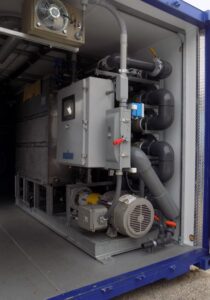
For more information on anaerobic digester and aerobic membrane bioreactor followed by reverse osmosis, please contact us today.
